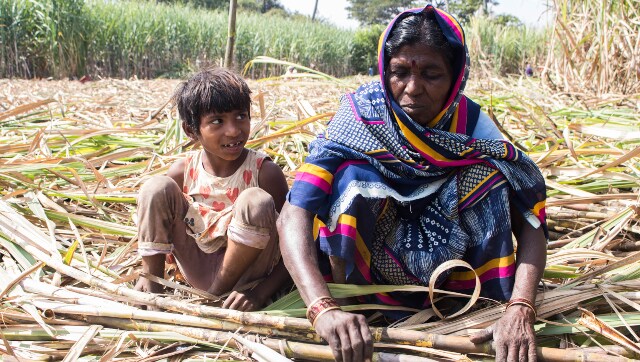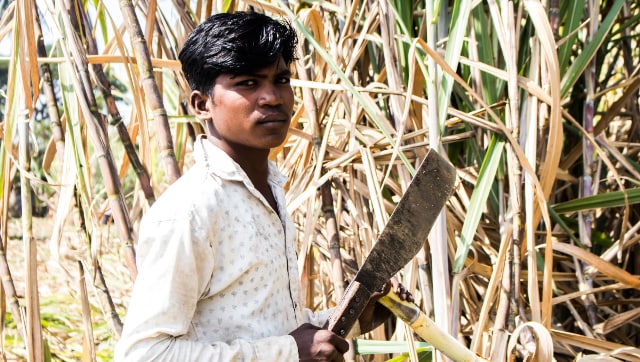The year 2020 has changed Swapnil Dhawale’s understanding of time. The 21-year-old, along with his mother and grandmother, cut 1,50,000 kilos of sugarcane in less than four months – all with a mere koyta (sickle) – after being forced to migrate 430 kilometres to do this work. Swapnil, who has enrolled in a college in the Manwath taluka of Maharashtra’s Parbhani district, was due to graduate in a year. However, the past four months have left the Commerce student feeling that his decade-long struggle to get educated is ending in a nightmare. * After the lockdown was declared on 24 March 2020, Swapnil and a hundred other students were issued a notice to vacate their hostel immediately. “Our hostel was converted into a COVID-19 facility,” he says. During the course of the lockdown, the Parbhani district, like other parts of Maharashtra, saw a decline in agricultural work, affecting the lives of countless labourers. His family of three, reeling under the repayment of a half-a-decade-old loan, was now faced with dwindling rural wages and work. The story of this loan goes back to the time when Swapnil met with an accident when he was in Class 9 – an accident that rendered his left eye permanently damaged. “We had to pay Rs 90,000 for the eye surgery in Mumbai, but even after it, he can’t see,” says his grandmother Sakubai, a woman in her early 60s, who is chopping away at sugarcane stalks. How did they source this loan of Rs 90,000? In Manwath’s Karanji village, for several decades, the only answer to such problems has been upper caste moneylenders. Swapnil says, “Our whole lives will be debt-riddled.” The pain is evident in his voice. This year, they had to repay the moneylender. “We took a loan of Rs 86,000 from the mukadam (labour contractor) to repay the loan,” his mother Sangeeta, 35, explains. * Each year, mukadams take sugarcane workers to fields in Western Maharashtra and the Belagavi district of Northern Karnataka to cut cane for six months. Mukadams work on a commission basis and don’t enter into written contracts with the workers. Obtaining Rs 86,000 in advance meant cutting over 315 tonnes of sugarcane in less than six months. Usually, couples sign up to be cane cutters (such a couple is locally referred to as a koyta). In case a spouse is unavailable to work, either children or relatives pitch in. For more than five years, Sangeeta and Sakubai have been doing this work. However, with no one at home, no local employment, and a newer, larger target, Swapnil was forced to enter this line of work. [caption id=“attachment_9197131” align=“alignnone” width=“640”]  21-year-old Swapnil Dhawale cut 1,50,000 kilos of sugarcane with his mother and grandmother in less than four months, with mere sickles.[/caption] “No learning has taken place ever since March. The college doesn’t even send lessons to access on our phones,” says Swapnil, who began working in the sugarcane fields in August 2020. For over nine months now, several educational institutions in Maharashtra have remained shut. He fears that if his college doesn’t restart anytime soon, he will be caught in a constant cycle of repaying debt, and eventually drop out. For Swapnil, who belongs to a Scheduled Caste, accessing education has been a challenge at every step. As per the U- DISE 2015-16 report, the drop-out rate at the Secondary level is as high as 19.36 percent for Scheduled Castes in India.
Swapnil is paying the price for policy makers’ ad hoc decision – offering e-learning as a ‘viable alternative’ during the lockdown.
The U-DISE report further says that of the 89 percent of disabled students enrolled in Elementary education, only two percent make it to Higher Secondary Education. * Swapnil’s work day begins at 6 AM and ends at 9 PM, sometimes even extending till midnight. His work entails cutting the cane, hauling and tying the stalks, and then loading them into a trailer. When I meet Swapnil in the last week of December, he has barely slept for eight hours over two days. This work involves an irreversible cost in terms of both Swapnil’s educational prospects, as well as his health, which will probably never heal. Once while cutting cane, his right hand was injured by the sickle’s sharp blade. Instead of going to the hospital, he had to find an immediate alternative solution. “I applied chuna (soda lime) and decided to go to the hospital later. If we skip work or even take a break, we are harassed into paying fines of Rs 300 for (not) cutting the cane and Rs 300 for loading it,” he explains. This fine is higher than what a couple manages to earn for cutting 2000 kilos of sugarcane in a day, after having collectively worked for at least 28 hours. They are paid a mere Rs 273 for thousand of kilos of sugarcane, which boils down to a mere Rs 0.27 per kg. “Even if there are any relief packages for us, who do you think will tell the daily wage earners about this?” Swapnil asks. Till December, the work done by three members of the Dhawale family amounted to Rs 41,000. There are three months more for them to reach their loan target. When I ask Sangeeta if they will be able to cut enough sugarcane to clear the advance in time, she says, “As per my calculation, we will finish it, but it all depends on how the mukadam calculates the loan now." This is an example of the malpractice mukadams often resort to – getting more work done for a paltry price. * Of the 36 other sugarcane cutters working in a two-acre land in Kolhapur district’s Yadrav village, over 12 are children and teenagers from the Marathwada belt, risking their lives and educational prospects. One among them is eight-year-old Sonu Pakhre, a Class 1 student of the zilla parishad school in Parbhani’s Khabra village. Sonu is often seen busy helping her grandmother, 55-year-old Indubai, to tie the sugarcane bundles. As early as 5.30 AM, Sonu walks for over three kilometres with one of her family members to fetch water. She also helps her mother make bhakris (a roti made out of jowar). She has an added responsibility of taking care of her two younger siblings – Yuvraj, 4, and Sugandha, 1. [caption id=“attachment_9197141” align=“alignnone” width=“640”]  Sonu Pakhre helps her grandmother Indubai to tie sugarcane bundles.[/caption] Sonu’s father, Rama, 32, can ill-afford a mobile data pack for her e-learning needs. “The government doesn’t want to help us. If our children study, then who will cut the sugarcane, is what they think. It’s a trap to keep the poor poorer,” he says, frustrated. * A panoramic view of the sugarcane field reveals agrarian disaster, exploitation, violations of child laws and labour laws, among other issues. “Look at how our children sleep between two sugarcane stalks in a saree,” says Indubai as she points towards a hammock-like make-shift structure. As per an International Labour Organization report, every year, two lakh children migrate with their parents to cut cane in Western Maharashtra. With the COVID-19 pandemic and shrinking employment opportunities, these numbers may have risen. “Sustained disruption of education could lead to a rise in child labour and child marriage, placing a further brake on developing countries’ growth,” warns a March 2020 United Nations report. As per the National Family Health Survey 2019-2020, only 40.7 percent of women from rural Maharashtra between the ages of 15 and 49 had completed 10-plus years of schooling. An ill-planned lockdown and an incompetent COVID-19 response exposed why these numbers might soar. Gender bias and the patriarchy make the effects of such a crisis more severe on girl children. Even when it comes to accessing e-learning, there is a significant gender gap. The National Family Health Survey also points out that only 23.7 percent of women from rural Maharashtra had used the internet, while the number for men is double at 47.2 percent. * Collectively, 11 members of the Pakhre family have taken an advance of Rs 3,70,000. This group features a worried 16-year-old, Ishwar, who will appear for the Class 10 board examination in the next few months. “For the entire year, I couldn’t study. I don’t have an e-learning facility, which is why I migrated with my family to work in the sugarcane fields.” In the event that Ishwar does not pass, there’s a higher probability of him dropping out because of the failure and the stigma attached. Like thousands of students across the country, he used to stay in the school hostel and was asked to vacate it in March. Ishwar’s father, Devrao, a man in his early 50s, says, “We couldn’t study because of poverty, and COVID-19 is resulting in the same fate for our children.” [caption id=“attachment_9197171” align=“alignnone” width=“640”]  16-year-old Ishwar, who is working in the sugarcane fields for the first time, is worried about his Class 10 board exams that will be held in the next few months.[/caption] While more privileged parts of the world swiftly moved towards e-learning, it wasn’t the best alternative for 19-year-old Sumedh Jogdand. The reason: he’s a first-year student enrolled in an Industrial Training Institute (ITI) Machinist course. “It’s a practical course, and every day, we work with machines to understand concepts,” he says. His college has been sending reading material on WhatsApp, but that isn’t helpful because none of the machinery required to make sense of these concepts is available to him, or in his proximity. “I don’t have enough money to recharge my phone connection and mobile data either,” he says. His mother Rekha, 35, who separated from her partner 12 years ago, has to depend on one of her children to help her cut sugarcane. For the past few years, it was Sumedh who would accompany her. However, with no work in the village, her younger son Avinash, 18, was forced to join. “I’m engaged in this work for the first time,” says Avinash. In these pressing times, Rekha believes she made a big mistake by taking an advance payment of Rs 80,000. Now she hopes to get done with the work immediately and start taking an ‘effective’ treatment for her mouth infection. “For the past six to seven years, we’ve visited both government and private hospitals over 15 times, but all they do is prescribe medicines, and after the medicines are finished, the problem resurfaces,” she explains. Every month, she has to spend Rs 1500 on medicines. This time, Rekha ran out of money as she had to buy ration. “I can’t even afford to eat properly now,” she adds. Such health conditions are an added burden on cane cutters, who often are forced to seek loans at exorbitant interest rates due to the rapid privitisation of healthcare. Avinash quit school three years ago and began accompanying Rekha to fields in the Manwath taluka. She now fears that entering into a vicious debt cycle will eventually force Avinash to take up this work permanently. Avinash’s life story reveals that bleak educational prospects aren’t a new issue. This crisis has always existed, the COVID-19 pandemic has only catalysed it. “We will be here till April (2021) at least. Our college will keep sending the coursework online, but I don’t know if I will be able to study anything this year,” says Sumedh. An estimated 6.2 crore children between the age group of 6 and 18 were out of school in 2015, as per the 2019 National Education Policy report. It is not possible for millions of children to deal with systemic inequalities using make-shift solutions anymore.


)

)
)
)
)
)
)
)
)



